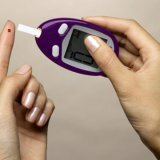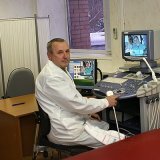Treatment of diabetic foot syndrome
 Currently, the diabetic foot syndrome is considered a very complex process of anatomical and functional changes, which is often found in various forms in 30-80% of people with diabetes mellitus. In this group of patients amputation of the lower extremities occurs much more often than in the rest of the population. A number of authors argue that 50-70% of the total number of all amputations of the lower limbs produced were made in patients with diabetes mellitus. In our country in 1993, about 12 thousand leg amputations were performed at various levels in patients with diabetes.
Currently, the diabetic foot syndrome is considered a very complex process of anatomical and functional changes, which is often found in various forms in 30-80% of people with diabetes mellitus. In this group of patients amputation of the lower extremities occurs much more often than in the rest of the population. A number of authors argue that 50-70% of the total number of all amputations of the lower limbs produced were made in patients with diabetes mellitus. In our country in 1993, about 12 thousand leg amputations were performed at various levels in patients with diabetes.
It is accepted to distinguish 3 main factors of the development of this syndrome: neuropathy, infection, lesion of the lower extremities.
Infection, as a rule, is usually associated with the first two factors. There are 2 main forms of the diabetic foot syndrome. Among them: neuropathic and ischemic.
Instead, experts identify the third form of foot syndrome - mixed( neuro-ischemic).
Neuropathic form is characterized by the defeat of the somatic and autonomic nervous system. Neuropathy often leads to such lesions of feet, as a neuropathic ulcer, osteoarthropathy, neuropathic edema.
Neuropathic abnormalities.
The ischemic form develops as a result of an atherosclerotic lesion of the arteries of the legs, which leads to disruption of the main blood flow. Neuropathic changes are also possible. But a decrease in pulsation or its absence on the arteries of the feet and shins, very cold extremities, pain, and the appearance of ulcerative defects allow us to distinguish between neuropathic forms of lesions from mixed ones.
A neuropathic defect is formed in the foot areas where the greatest pressure is felt. This leads to a slight deformation of the foot, which leads to redistribution of pressure and its excessive increase in some parts of the foot. In these places there is a thickening of the skin, the formation of hyperkeratoses with a sufficiently high density. Constant pressure on these sites inevitably leads to inflammatory autolysis of soft tissues, and also to the formation of a ulcerative defect. The patient at the same time may not notice the changes taking place with him because of low pain sensitivity.
Often the formation of ulcerative lesions is due to improper selection of shoes. This inevitably leads to significant deformation of the human foot. At the same time, often there is a neuropathic edema. As a result, the patient's foot changes not only the shape, but also the dimensions. Nevertheless, the patient picks up the shoes, based on their previous sizes. Reduced pain sensitivity does not allow the patient to feel the inconvenience of new shoes in time and therefore leads to unpleasant scuffs and ulcers.
Ulcers are often infected with staphylococci, various bacteria, streptococci. Anaerobic microflora often occurs. Microorganisms produce hyaluronidase, which promotes the propagation of necrotic changes in subcutaneous fat, bone-ligament apparatus, muscle tissue, there is a thrombosis of small vessels and an increase in affected tissue sites. In this case, urgent surgical treatment of diabetic foot syndrome is necessary, the appointment of adequate antibiotic treatment, careful monitoring of glycemia.
Timely and adequately conducted conservative treatment of an infected form of foot damage will help to avoid surgical intervention in 95 percent of cases.
Treatment in this case should include the following important components:
- Improved metabolic control by maintaining carbohydrate balance.
- Antibiotic therapy to prevent the penetration of microorganisms into the affected areas of the skin.
- Unloading the affected area with a wheelchair, crutches, special shoes.
- local wound treatment by removing necrotic tissue, treating ulcer edges, as well as ensuring aseptic wound surface and the surrounding areas.
- Removal of hyperkeratosis sites with a scalpel with a shortened blade.
- The correct selection of shoes, wearing special shoes.
Changes in bones are characterized by osteoporosis, as well as osteolysis and hyperostosis. Initial bone changes may not be noticeable in a retgenologic study. Therefore, an ultrasonic scanning method is used for early diagnosis. Changes in the bone can progress for several months and subsequently lead to a pronounced deformation of the foot.
development of these destructive changes increase the risk of bone fractures in these patients compared with those without neuropathy.
patients with fractures of the recommended full discharge of the affected limb, and in the future - using only a special orthopedic shoes.
Due to neuropathy, it is possible to accumulate fluid in the tissues of the lower extremities. Initially, it is necessary to exclude other causes of puffiness, namely: heart failure or nephropathy. Reasons for the formation of edema are not conclusively determined, but we can say that they are the result of damage to the nervous system, resulting in the formation of various arteriovenous shunts and change the hydrodynamic pressure.
The most effective treatment for neuropathic edema is the use of sympathomimetics, for example, ephedrine. It has a very rapid effect, which is to reduce peripheral blood flow and increase sodium excretion. In addition, ephedrine also has a central regulating effect on water-salt metabolism.
The ischemic form of the diabetic foot is characterized by emerging bulbs, usually in a rest period. At the same time, slight relief occurs when the person's position changes. To reduce pain, lumbar sympathectomy is often prescribed, but there is no improvement in the dynamics of the lower limbs.
With ischemic lesion, unlike the neuropathic, the feet are cold. Ulcers occur as acrom necrosis. The causes of ulcerative defects are primarily: wearing tight shoes, deformity and swelling of the foot. To this, a secondary infection is often added.
Treatment of ischemic form of diabetic foot syndrome , boils down to:
- use conservative therapy,
- reconstructive surgery( after failure of conservative therapy),
- appointment of adequate antibiotic therapy and conducting dehydration therapy in patients with disorders of the cardiovascular system.



